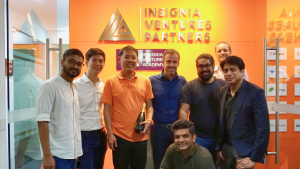As part of XA Network’s “Meet the VC” series, their members gathered at our office for a discussion with Yinglan Tan on investing, tech, and Southeast Asia, moderated by XA member and Insignia founder, JJ Chai, CEO and co-founder of Rainforest.

Yinglan and XA members at the Insignia office
Part of the discussion was on market trends, and we thought to share some of the insights from this discussion, framed along the lines of how Southeast Asia’s role in the global landscape of tech, startups, and venture capital is evolving:
(1) A destination to increase capital productivity, especially from Japan.
More strategics from Japan are taking advantage of the country’s economic environment to deploy capital in Southeast Asia. This builds on the momentum of investments into the region’s digital economy in recent years, like Mizuho into the Philippines’ digital banking moment through Tonik. But this opportunity is more than just about fundraising. It represents stronger synergies for companies able to leverage the expertise that comes with Japanese corporate capital, especially when it comes to financial services, as well as opportunities for expansion into Japan (through M&A or strategic ventures).
(2) A launchpad for entrepreneurs from mature markets to reach a global market.
This is most notably the case in China, where we have documented quite extensively how entrepreneurs from the country have sought to start new ventures from SEA countries like Singapore to target a global market. A specific example is WIZ.AI, where you have Chinese entrepreneur and VC founding team that set up shop in Singapore to build a voice and generative AI company that now serves 300+ corporates globally, including LatAm.
Apart from China, we also see momentum in Indian entrepreneurs also moving to Singapore to start SaaS companies and sell to the US, taking advantage of being headquartered in Singapore perhaps having operations in neighboring countries like Malaysia, and ultimately tapping into high willingness to pay from US customers.
(3) A testbed for vertical Gen AI apps.
While the costs and challenges are quite high for Southeast Asian markets to produce startups in the model or infrastructure layer of the AI value chain (except maybe for semiconductors), the application layer is ripe for the taking. This is important in the global context of the Gen AI industry given a major challenge for Gen AI apps is to actually find strong differentiation, best defined by distribution and perceived value from customers.
Southeast Asian industries, with the nuances of language, social cues, and regulation — all of which are important factors for LLM accuracy — provide an opening for such apps to be built. Examples of such industries or use cases are legal as well as wealth management (see how one such platform, Finhay, in Vietnam is leveraging on AI to improve the retail investor experience).
(4) A fertile ground for the marriage of embedded finance and trade.
Products are emerging to meet the cashflow needs for businesses to expand or in some cases, enter new markets. It can range from supply chain based financing for MSMEs (see AwanTunai), to a platform for fisheries businesses to access financing for exports, or flexible financing for B2B buyers (see Fluid).
(5) A funnel for global wellness solutions.
Wellness goes beyond the typical health tech play of telemedicine, diagnosis, and treatment to solutions that are plugged into the day to day living for its end users, whether it’s for weight management (see Elevate by Ease)or mental wellbeing.
When it comes to commercialization opportunities for such solutions, Southeast Asian markets are generally limited given the spending power of consumers and where such wellness products might lie in their list of priorities.
This represents a business case for companies to capitalize more on markets with more developed healthcare industries, i.e., where costs might be subsidized more efficiently by insurance and there is relatively less market education required to drive adoption. Singapore is one market in Southeast Asia, but not enough for a sizable venture outcome in the space.
Another approach is to go the B2B or enterprise route and leverage the multinational presence of organizations to reach more markets faster. Such has been the playbook of Intellect with their mental healthcare program for employees that has reached markets like Taiwan, Japan, as well as the US.
Higher ARPU, Sweet Spots, and Resource Upside
Common threads across these trends are companies seeking greater commercialization opportunities (i.e., higher ARPU) beyond Southeast Asian markets (AI and wellness), finding that sweet spot in the atoms versus bits and regulated versus non-regulated matrix (embedded finance and trade), and taking advantage of Singapore and the region’s upside in terms of capital and talent.
Paulo Joquiño is a writer and content producer for tech companies, and co-author of the book Navigating ASEANnovation. He is currently Editor of Insignia Business Review, the official publication of Insignia Ventures Partners, and senior content strategist for the venture capital firm, where he started right after graduation. As a university student, he took up multiple work opportunities in content and marketing for startups in Asia. These included interning as an associate at G3 Partners, a Seoul-based marketing agency for tech startups, running tech community engagements at coworking space and business community, ASPACE Philippines, and interning at workspace marketplace FlySpaces. He graduated with a BS Management Engineering at Ateneo de Manila University in 2019.